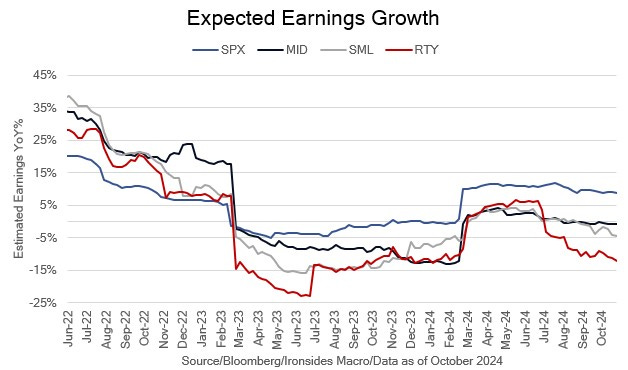Eight (or Nine) Crazy Days
Labor Week, Belly (2s, 5s & 7s) Week, QRA, Election & The Fed with the market all in on the Trump Trade. Put your seat & tray tables in their upright position.
Seats & Tray Tables in the Upright Position
“On balance, economic activity was little changed in nearly all Districts since early September, though two Districts reported modest growth.” Federal Reserve Beige Book
Put your seats and tray tables in their upright position, through our 40 years we can’t recall an 8–9-day period with more important economic and policy scheduled events. With all eyes on the election and the fixed income implied volatility premium on the day following the election evidence that short Treasuries is the most consensus Trump trade, there will be highly significant economic releases, Treasury supply and policy developments each of the next eight/nine trading days (or more if the election isn’t settled) that could accelerate the Treasury selloff or cause a vicious short covering rally. On Monday Treasury auctions $69 billion of 2-year notes (2s) and $70bn of 5s and announces their borrowing requirements for the next two quarters. The most important, but not only, events on Tuesday, are the September Job Openings & Labor Turnover (JOLTS) report, the October Conference Board Labor Differential and Treasury auctions $44 billion of 7s. Wednesday brings the October ADP employment report, the 3Q advanced GDP guesstimate, and the Treasury quarterly refunding announcement (QRA) that details the mix of bills, notes and bonds to meet their borrowing requirements. On Thursday we get the underappreciated by market participants, but not FOMC members, 3Q employment cost index as well as the Fed’s inflation target October personal consumption deflator. The week ends with the October employment report. Not to be overshadowed, equity investors will have their attention focused on earnings from Alphabet on Tuesday, Meta and Microsoft on Wednesday and Amazon and Apple on Thursday. Next week’s labor market data, Treasury supply developments and Mag7 earnings are just a warmup for the election and FOMC meeting the following week.
In two notes this month, Productivity Boom: Cyclical or Secular? and The Trump Trade, we detailed our view that seasonal adjustment factors created to smooth employment growth and retail sales were corrupted by the pandemic policy panic when policymakers closed schools in 2020, leading to September data that overestimated demand for labor and consumer spending. Specifically, the surge in the employment ratio for the 16-24 age group that boosted employment and lowered the unemployment rate and strong consumer spending in the month after back-to-school sales, were pandemic related statistical quirks that actually never really happened. Two consecutive soft Beige Book Surveys, as well as tepid 3.5% 3Q S&P 500 earnings growth, suggest growth is well below the Atlanta Fed GDP Now tracking model 3.4% pace.
Treasury investors, including large banks who added $330 billion in Treasury and agency securities this year in anticipation of FOMC rate cuts and yield curve disinversion, are reeling from the 55bp increase in 10-year USTs since the 50bp mid-September start to the rate recalibration cycle. The primarily catalysts for the Treasury market correction, were the nominal gross domestic income benchmark 1H24 revision to 6% from 4.5% in late September, the drop in the September unemployment rate from 4.22% to 4.05% in early October, a hotter than expected 0.3% increase in core CPI attributable to a 0.51% in non-housing services prices and 0.7% increase in core retail sales that boosted the 3Q annualized pace to 6.4% in mid-October, combined with a deteriorating outlook for federal finances. In other words, improving growth, hotter inflation and more supply. As was the case during the ‘51-’81 bond bear market, countertrend rallies since the ‘20 secular low in rates, occur when recession risk escalates.
The growth narrative is unlikely to be completely derailed debate next week, in part due to hurricane and strike related data distortions, but the October employment report, 3Q employment cost index, 3Q advanced GDP estimate, and October Vehicle Sales are likely to weaken the strengthening growth narrative. Given how macro investors appear to be leaning into positions Paul Tudor Jones in a CNBC interview characterized as inflation trades, long gold and bitcoin, short Treasuries and long equities, weak data next week ahead of the election could shake out the weak hands.
In this week’s note, we will provide our case for why the Goldman 10-year forecasts for equities underperforming USTs are likely to be incorrect, discuss the Treasury 2025 supply outlook under the two most probable election scenarios, offer a preview of the FOMC meeting, and add our thoughts on 3Q earnings season with 30% of the S&P 500 in the books.
For those of you who are receiving the introductory version of these notes this would be a good time to subscribe. We will be using the chat feature to update our full subscribers through this packed period of macro events and providing an employment outlook note. Additionally, shortly after the election we will begin work on our three annual outlook notes; a ‘25 outlook, macro themes for the business cycle and the year in review note.





